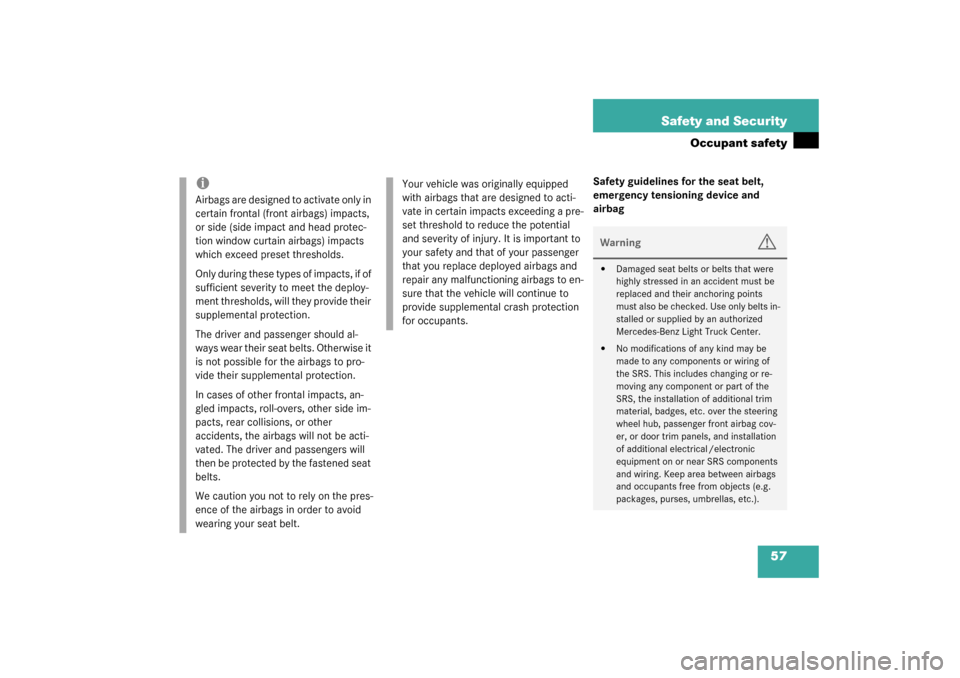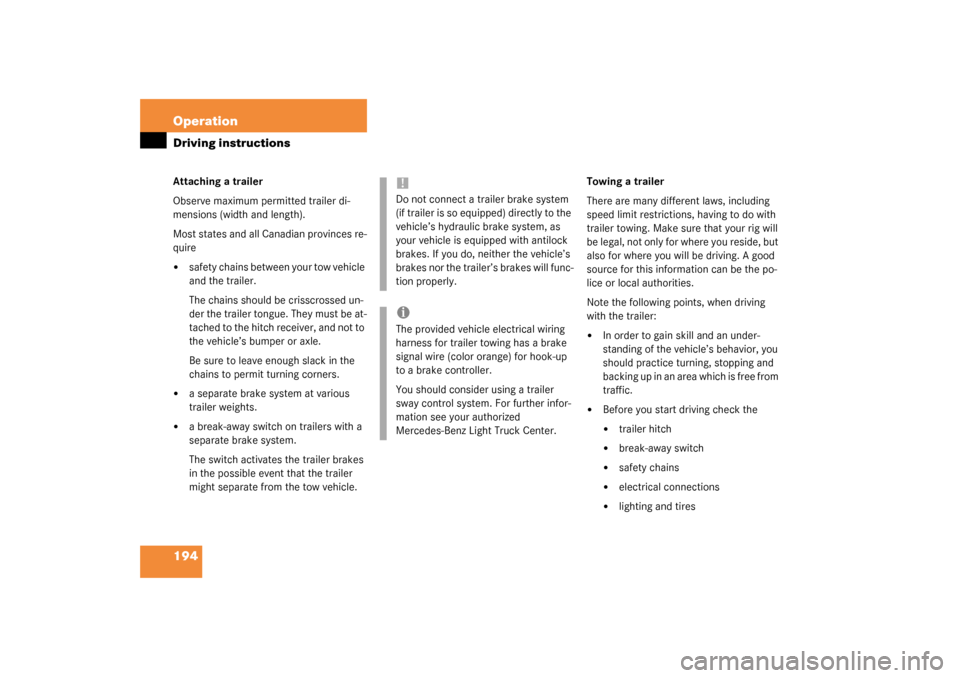Page 57 of 321

57 Safety and Security
Occupant safety
Safety guidelines for the seat belt,
emergency tensioning device and
airbag
iAirbags are designed to activate only in
certain frontal (front airbags) impacts,
or side (side impact and head protec-
tion window curtain airbags) impacts
which exceed preset thresholds.
Only during these types of impacts, if of
sufficient severity to meet the deploy-
ment thresholds, will they provide their
supplemental protection.
The driver and passenger should al-
ways wear their seat belts. Otherwise it
is not possible for the airbags to pro-
vide their supplemental protection.
In cases of other frontal impacts, an-
gled impacts, roll-overs, other side im-
pacts, rear collisions, or other
accidents, the airbags will not be acti-
vated. The driver and passengers will
then be protected by the fastened seat
belts.
We caution you not to rely on the pres-
ence of the airbags in order to avoid
wearing your seat belt.
Your vehicle was originally equipped
with airbags that are designed to acti-
vate in certain impacts exceeding a pre-
set threshold to reduce the potential
and severity of injury. It is important to
your safety and that of your passenger
that you replace deployed airbags and
repair any malfunctioning airbags to en-
sure that the vehicle will continue to
provide supplemental crash protection
for occupants.
Warning
G
�
Damaged seat belts or belts that were
highly stressed in an accident must be
replaced and their anchoring points
must also be checked. Use only belts in-
stalled or supplied by an authorized
Mercedes-Benz Light Truck Center.
�
No modifications of any kind may be
made to any components or wiring of
the SRS. This includes changing or re-
moving any component or part of the
SRS, the installation of additional trim
material, badges, etc. over the steering
wheel hub, passenger front airbag cov-
er, or door trim panels, and installation
of additional electrical /electronic
equipment on or near SRS components
and wiring. Keep area between airbags
and occupants free from objects (e.g.
packages, purses, umbrellas, etc.).
Page 185 of 321

185 Operation
Driving instructions
This can bring road salt impaired braking
efficiency back to normal. Be very careful
that you carry out these braking maneu-
vers without endangering any other road
users.
If the vehicle is parked after being driven
on salt-treated roads, the braking efficien-
cy should be tested as soon as possible af-
ter driving is resumed while observing the
safety rules in the previous paragraph.
For more information on winter driving
(
�page 213).
Standing water
Warning!
G
If the vehicle becomes stuck in snow, make
sure that snow is kept clear of the exhaust
pipe and from around the vehicle with the
engine running. Otherwise, deadly carbon
monoxide (CO) gases may enter vehicle in-
terior resulting in unconsciousness and
death.
To assure sufficient fresh air ventilation,
open a window slightly on the side of the ve-
hicle not facing the wind.
Warning!
G
The outside temperature indicator is not de-
s i g n e d t o s e r v e a s a n i c e - w a r n i n g d e v i c e a n d
is therefore unsuitable for that purpose. In-
dicated temperatures just above the freez-
ing point do not guarantee that the road
surface is free of ice.
!Do not drive through flooded areas or
water of unknown depth. Before driving
through water, determine its depth. It
should not be deeper than approxi-
mately 20 inches (50 cm).
If you must drive through standing wa-
ter, drive slowly to prevent water from
entering the passenger compartment
or the engine compartment. Water in
these areas could cause damage to
electrical components or wiring of the
engine or transmission, or could result
in water being ingested by the engine
through the air intake causing severe
internal engine damage. Any such dam-
age is not covered by the Mer-
cedes-Benz Limited Warranty.
Page 194 of 321

194 OperationDriving instructionsAttaching a trailer
Observe maximum permitted trailer di-
mensions (width and length).
Most states and all Canadian provinces re-
quire�
safety chains between your tow vehicle
and the trailer.
The chains should be crisscrossed un-
der the trailer tongue. They must be at-
tached to the hitch receiver, and not to
the vehicle’s bumper or axle.
Be sure to leave enough slack in the
chains to permit turning corners.
�
a separate brake system at various
trailer weights.
�
a break-away switch on trailers with a
separate brake system.
The switch activates the trailer brakes
in the possible event that the trailer
might separate from the tow vehicle.Towing a trailer
There are many different laws, including
speed limit restrictions, having to do with
trailer towing. Make sure that your rig will
be legal, not only for where you reside, but
also for where you will be driving. A good
source for this information can be the po-
lice or local authorities.
Note the following points, when driving
with the trailer:
�
In order to gain skill and an under-
standing of the vehicle’s behavior, you
should practice turning, stopping and
backing up in an area which is free from
traffic.
�
Before you start driving check the�
trailer hitch
�
break-away switch
�
safety chains
�
electrical connections
�
lighting and tires
!Do not connect a trailer brake system
(if trailer is so equipped) directly to the
vehicle’s hydraulic brake system, as
your vehicle is equipped with antilock
brakes. If you do, neither the vehicle’s
brakes nor the trailer’s brakes will func-
tion properly.iThe provided vehicle electrical wiring
harness for trailer towing has a brake
signal wire (color orange) for hook-up
to a brake controller.
You should consider using a trailer
sway control system. For further infor-
mation see your authorized
Mercedes-Benz Light Truck Center.